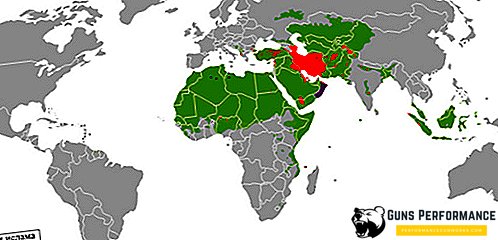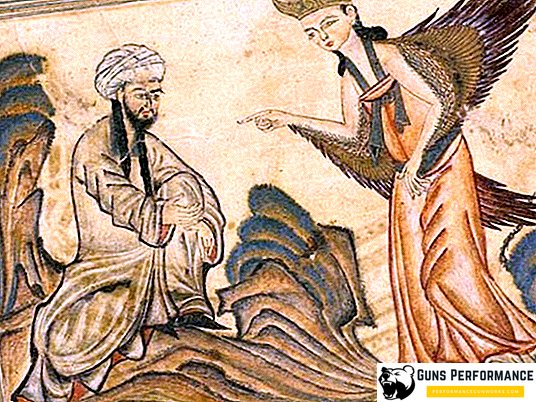
In recent years, the Middle East has not left the news headlines of world news agencies. The region is in a fever, the events taking place here largely determine the global geopolitical agenda. In this place the interests of the largest players in the world arena are intertwined: the USA, Europe, Russia and China.
To better understand the processes taking place today in Iraq and Syria, it is necessary to look into the past. The contradictions that led to the bloody chaos in the region are connected with the peculiarities of Islam and the history of the Muslim world, which today is experiencing a real passionate explosion. Every day the events in Syria are more and more reminiscent of a religious war, uncompromising and merciless. This has already happened in history: the European Reformation led to centuries of bloody conflict between Catholics and Protestants.
And if, immediately after the events of the Arab Spring, the conflict in Syria resembled the usual armed uprising of the people against the authoritarian regime, then today the opposing sides can be clearly divided on religious grounds: President Alawi and Shiites support President Assad in Syria, and most of his opponents are Sunni (both of these branches are recognized illegal in the territory of the Russian Federation). Of the Sunnis - and of the most radical sense - consist of troops of the Islamic State (ISIL) - the main "horror stories" of any Western man in the street.
Who are the Sunnis and Shiites? What is the difference? And why exactly now the difference between the Sunnis and the Shiites has led to armed confrontation between these religious groups?

To find answers to these questions, we will have to make a journey through time and go back thirteen centuries ago, during the period when Islam was a young religion in its infancy. However, before this, some general information that will help to better understand the issue.
The flow of Islam
Islam is one of the largest world religions, which is in second place (after Christianity) in the number of followers. The total number of its adherents is 1.5 billion people living in 120 countries of the world. In 28 countries, Islam declared the state religion.
Naturally, such a massive religious teaching cannot be homogeneous. The structure of Islam includes many different trends, some of which are considered marginal even by Muslims themselves. The two largest areas of Islam are Sunni and Shi'ism. There are other, less numerous currents of this religion: Sufism, Salafism, Ismailism, Jamaat Tabliq and others.

The history and essence of the conflict
The split of Islam into Shiites and Sunnis occurred shortly after the emergence of this religion, in the second half of the 7th century. At the same time, his reasons concerned not so much the dogmas of faith as pure politics, but, more precisely, the banal struggle for power led to a split.
After the death of Ali, the last of the four Righteous Caliphs, the struggle for his place began. Opinions about the future heir were divided. Some Muslims believed that only a direct descendant of the Prophet’s family, to whom all his spiritual qualities should go, could lead a caliphate.

The other part of the believers believed that any worthy and authoritative person, who would be elected by the community, could become a leader.
Caliph Ali was a cousin and son-in-law of the prophet, therefore a significant part of the believers believed that the future ruler should be chosen from his family. Moreover, Ali was born in Kaaba, he was the first man and child to convert to Islam.
Believers, who believed that Muslims should be ruled by people from the Ali clan, formed the religious current of Islam, called “Shiism”, respectively, its followers were called Shiites. Translated from Arabic, the word means "devotees, followers (Ali)." Another part of the believers, who considered the exclusivity of this kind of doubtful, formed the course of the Sunnis. This name appeared because the Sunnis confirmed their position with quotations from the Sunnah - the second most important source of Islam in the Koran.

By the way, the Shiites consider the Quran, recognized by the Sunnis, to be partially falsified. According to them, information about the need to appoint Ali as Muhammad’s receiver was removed from him.
This is the main and main difference between Sunnis and Shiites. It became the cause of the first civil war that occurred in the Arab caliphate.
However, it should be noted that the further history of relations between the two branches of Islam, although it was not too bright, but Muslims managed to avoid serious religious conflicts. Sunni has always been more, a similar situation persists today. It was precisely representatives of this branch of Islam that founded such powerful states in the past as the Umayyad and Abbasid caliphates, as well as the Ottoman Empire, which during its heyday was the real thunderstorm of Europe.
In the Middle Ages, Shiite Persia constantly quarreled with the Sunni Ottoman Empire, which largely prevented the latter from completely conquering Europe. Despite the fact that these conflicts were more likely politically motivated, religious differences also played a significant role in them.

The controversy between the Sunnis and the Shiites came to a new stage after the Islamic Revolution in Iran (1979), after which the theocratic regime came to power. These events put an end to Iran’s normal relations with the West and its neighboring states, where the Sunnis were mostly in power. The new Iranian government began to pursue an active foreign policy, which was regarded by the countries of the region as the beginning of Shiite expansion. In 1980, the war began with Iraq, the overwhelming majority of whose leadership was occupied by Sunnis.
The Sunni and Shia confrontation came to a new level after a series of revolutions (known as the "Arab Spring"), sweeping across the region. The conflict in Syria clearly divided the warring parties on a confessional basis: the Syrian Alawite president is being defended by the Iranian Islamic Guard Corps and the Shiite Hezbollah from Lebanon, and opposed by Sunni militants supported by various states in the region.
What else are different Sunnis and Shiites
Sunnis and Shiites have other differences, but they are less fundamental. So, for example, Shahad, which is the verbal expression of the first pillar of Islam ("I testify that there is no God except Allah, and testify that Muhammad is the Prophet of Allah"), the Shiites sound somewhat different: at the end of this phrase they add "... and Ali - the friend of Allah. "
There are other differences between the Sunni and Shiite branches of Islam:
- Sunnis worship only the Prophet Muhammad, and Shiites, in addition, praise his cousin Ali. The Sunnis worship the entire text of the Sunnah (their second name is "the Sunnai people"), and the Shiites only part of it that concerns the Prophet and his family members. Sunnis believe that following the Sunnah is one of the main duties of a Muslim. In this regard, they can be called dogmatists: the Taliban in Afghanistan strictly regulates even the details of a person’s appearance and behavior.
- If the largest Muslim holidays, Uraza Bayram and Kurban Bayram, are celebrated in the same way by both branches of Islam, the tradition of celebrating the day of Ashur among Sunnis and Shiites has a significant difference. For Shiites, this day is a memorial.
- Sunnis and Shiites have a different attitude to such a rule of Islam, as a temporary marriage. The latter consider this a normal phenomenon and do not limit the number of such marriages. Sunnis consider such an institution illegal, since Mohammed himself abolished it.
- There are differences in the places of traditional pilgrimage: the Sunnis visit Mecca and Medina in Saudi Arabia, and the Shiites visit Iraqi Najaf or Karbala.
- Sunnis should perform five prayers (prayers) a day, and Shiites can limit to three.
However, the main thing in which these two directions of Islam differ is the way of choosing power and attitude to it. Sunni imam - it's just a spiritual person who dominates the mosque. A completely different attitude to this issue among the Shiites. The head of the Shiites, the imam, is the spiritual leader who governs not only matters of faith, but also politics. He stands above the state structures. Moreover, the imam should come from the clan of the prophet Mohammed.

A typical example of this form of government is Iran today. The head of Iran’s Shiites, Rahbar, is higher than the president or head of the national parliament. He completely determines the policy of the state.
Sunnis do not believe in the infallibility of the people, and the Shiites believe that their imams are completely sinless.
Shiites believe in twelve righteous imams (Ali's descendants), the fate of the last of which (his name was Muhammad al-Mahdi) is unknown. He simply disappeared without a trace at the end of the 9th century. Shiites believe that al-Mahdi will return to the people on the eve of the Last Judgment to bring order to the world.
Sunnis believe that after death, the soul of a person can meet with God, and Shiites consider such a meeting impossible both in human life on earth and after it. Communication with God can only be maintained through the Imam.
It should also be noted that the Shiites practice the principle of "takiya", this means the pious concealment of their faith.
The number and place of residence of the Sunnis and Shiites
How many sunnites and shiites in the world? Most of the Muslims living on the planet today belong to the Sunni trend of Islam. According to various estimates, they make up from 85 to 90% of the followers of this religion.
Most Shiites live in Iran, Iraq (more than half of the population), Azerbaijan, Bahrain, Yemen and Lebanon. In Saudi Arabia, Shi'ism is practiced by about 10% of the population.
Sunnis make up the majority in Turkey, Saudi Arabia, Kuwait, Afghanistan, and the rest of Central Asia, Indonesia, and North African countries: Egypt, Morocco, and Tunisia. In addition, the majority of Muslims in India and China belong to the Sunni trend of Islam. Russian Muslims also belong to the Sunnis.
As a rule, there are no conflicts between the adherents of these Islamic trends when living together in the same territory. Sunnis and Shiites often visit the same mosque, and it also does not cause conflicts.
The current situation in Iraq and Syria is more likely an exception due to political reasons. This conflict is associated with the opposition of the Persians and Arabs, rooted in the darkest depth of the ages.
Alawites
In conclusion, I would like to say a few words about the Alawite religious group, to which the current Russian ally in the Middle East belongs - Syrian President Bashar Assad.

Alawites is a current (sect) of Shiite Islam, with which it is united by the worship of the Prophet’s cousin, Caliph Ali. Alavism originated in the IX century on the territory of the Middle East. This religious movement absorbed the features of Ismaili and Gnostic Christianity, and the result was a "explosive mixture" of Islam, Christianity, and various pre-Muslim beliefs that existed in these territories.
Today, Alawites make up 10-15% of the population of Syria, their total number is 2-2.5 million people.
Despite the fact that Alavism originated on the basis of Shiism, it is very different from it. Alawites celebrate some Christian holidays, such as Easter and Christmas, perform only two namaz per day, do not attend mosques, and can drink alcohol. Alawites worship Jesus Christ (Isa), Christian apostles, they read the Gospel at their divine services, they do not recognize the Shari'ah.
And if radical Sunnis from among the fighters of the Islamic State (ISIL) are not too good at Shiites, considering them to be "wrong" Muslims, then they generally call Alawites dangerous heretics, which must be destroyed. Attitude towards the Alawites is much worse than toward Christians or Jews, Sunnis believe that the Alawites offend Islam by the mere fact of their existence.
Not much is known about the religious traditions of the Alawites, since this group actively uses the practice of takia, which allows believers to perform the rites of other religions, while maintaining their faith.












